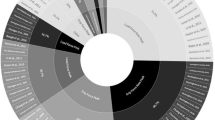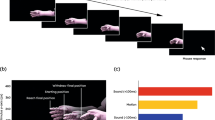Abstract
Object-directed grasping movements are usually adjusted in anticipation of the direction and extent of a subsequent object rotation. Such anticipatory grasp selections have been mostly explained in terms of the kinematics of the arm movement. However, object rotations of different directions and extents also differ in their dynamics and in how the tasks are represented. Here, we examined how the dynamics, the kinematics, and the cognitive representation of an object manipulation affect anticipatory grasp selections. We asked participants to grasp an object and rotate it by different angles and in different directions. To examine the influence of dynamic factors, we varied the object’s weight. To examine the influence of the cognitive task representation, we instructed identical object rotations as either toward-top or away-from-top rotations. While instructed object rotation and cognitive task representation did affect grasp selection over the entire course of the experiment, a rather small effect of object weight only appeared late in the experiment. We suggest that grasp selections are determined on different levels. The representation of the kinematics of the object movement determines grasp selection on a trial-by-trial basis. The effect of object weight affects grasp selection by a slower adaptation process. This result implies that even simple motor acts, such as grasping, can only be understood when cognitive factors, such as the task representation, are taken into account.



Similar content being viewed by others
Notes
With grasp selection, we refer to the orientation of the hand and forearm when grasping the object.
If participants were within 3° of the target orientation the message “Ausgezeichnet!!!” (German for “Excellent!!!”) appeared. Within 3°–7.5°, the message “Sehr gut!” (“Very good!”) appeared. Within 7.5°–15°, the text “Gut, aber zu weit links/rechts.” (“Good, but too far to the left/right”) appeared, depending on the direction of the error. If errors exceeded 15°, the text “Fehler” (“error”) was shown. If participants were too slow or did not lift the cylinder, the text “Schneller oder Rad höher anheben” (“Faster or lift cylinder higher”) appeared.
This is supported by the data in two ways. First, at the time of grasping, the yaw (left–right) and pitch (up–down) angle of the forearm with respect to an external coordinate system revealed little variability over the trials of each participant (mean SDyaw = 7.3°, mean SDpitch = 6.6°, for comparison, the mean of the participants’ SD of FOGRASP was 66.4°). Second, on average, the difference between the highest and lowest yaw and pitch angle recorded during each cylinder rotation was 8.9° and 13.9°, respectively. The low variability of the forearms position shows that the forearm was stretched or only slightly flexed when grasping and moving the object, suggesting that FOGRASP reflects mostly pronation and supination of the forearm.
Greenhouse–Geisser corrected p values but uncorrected dfs are reported.
Descriptively, the cylinder presented in the first part tended to be grasped more supine, with the exception of away-from-top trials in blocks 3 + 4, resulting in a marginally significant interactions between weight, group, block (and stimulus type), p = 0.069 (and p = 0.063, respectively). No other effect approached significance, all ps ≥ 0.206.
Δstimulus = 0.5 × [(FOCCW,TOWARD-TOP − FOCCW,AWAY-FROM-TOP) + (FOCW,AWAY-FROM-TOP − FOCW,TOWARD-TOP)]; Δweight = 0.5 × [(FOCCW,HEAVY − FOCCW,LIGHT) + (FOCW,LIGHT − FOCW,HEAVY)]; where FO X,Y denotes FOGRASP averaged over all other factors than implied by X and Y. For examples, FOCCW,TOWARD-TOP refers to the FOGRASP averaged over all counterclockwise target angles and both weights.
MTROTs tended to decrease from the earlier blocks to the later blocks (p = 0.068). The interaction between rotation angle and stimulus type approached significance (p = 0.070). This interaction was neither based on a consistent effect of the rotation direction (p = 0.210) nor amplitude (p = 0.438). The three-way interaction between weight, group, and stimulus trials was modulated marginally by block (p = 0.080). All other effects did not approach significance (all ps ≥ 0.173).
The effect of block approached significance (p = 0.72, all other ps ≥ 0.089).
As our participants were mostly female, these values are likely to underestimate the exerted torques in the task respective the maximum torques our participants would be able to produce.
An inspection of single-trial data revealed that the absence of the effect of stimulus type on FOGRASP cannot be explained by the effect being present in a subset of trials and being subsequently averaged out in the aggregated data.
References
Aflalo TN, Graziano MSA (2007) Relationship between unconstrained arm movements and single-neuron firing in the macaque motor cortex. J Neurosci 27(11):2760–2780. doi:10.1523/JNEUROSCI.3147-06.2007
Bock O, Steinberg F (2012) Age-related deficits of manual grasping in a laboratory versus in an everyday-like setting. Ageing Res 4(e7):48–52. doi:10.4081/ar.2012.e7
Claxton LJ, Keen R, McCarty ME (2003) Evidence of motor planning in infant reaching behavior. Psychol Sci 14(4):354–356. doi:10.1111/1467-9280.24421
Collins T, Schicke T, Röder B (2008) Action goal selection and motor planning can be dissociated by tool use. Cognition 109(3):363–371. doi:10.1016/j.cognition.2008.10.001
Coren S (1993) The lateral preference inventory for measurement of handedness, footedness, eyedness, and earedness: norms for young adults. Bull Psychon Soc 31(1):1–3
Crajé C, Lukos J, Ansuini C, Gordon A, Santello M (2011) The effects of task and content on digit placement on a bottle. Exp Brain Res 212(1):119–124. doi:10.1007/s00221-011-2704-1
Eder AB, Rothermund K (2008) When do motor behaviors (mis)match affective stimuli? An evaluative coding view of approach and avoidance reactions. J Exp Psychol Gen 137:262–281
Gandolfo F, Mussa-Ivaldi FA, Bizzi E (1996) Motor learning by field approximation. Proc Natl Acad Sci USA 93:3843–3846
Herbort O (2012) Where to grasp a tool? Task-dependent adjustments of tool transformations by tool users. Zeitschrift für Psychol 220(1):37–43. doi:10.1027/2151-2604/a000089
Herbort O (2013) Optimal versus heuristic planning of object manipulations: a review and a computational model of the continuous end-state comfort effect. New Ideas Psychol 31:291–301. doi:10.1016/j.newideapsych.2013.01.003
Herbort O, Butz MV (2010) Planning and control of hand orientation in grasping movements. Exp Brain Res 202(4):867–878. doi:10.1007/s00221-010-2191-9
Herbort O, Butz MV (2011) Habitual and goal-directed factors in (everyday) object handling. Exp Brain Res 213(4):371–382. doi:10.1007/s00221-011-2787-8
Herbort O, Butz MV (2012) The continuous end-state comfort effect: weighted integration of multiple biases. Psychol Res 76(3):345–363. doi:10.1007/s00426-011-0334-7
Hughes CML, Franz EA (2008) Goal-related planning constraints in bimanual grasping and placing of objects. Exp Brain Res 188(4):541–550. doi:10.1007/s00221-008-1387-8
Hughes CML, Seegelke C, Reißig P, Schütz C (2012) Effects of stimulus cueing on bimanual grasp posture planning. Exp Brain Res 219(3):391–401. doi:10.1007/s00221-012-3100-1
Johnson SH (2000) Thinking ahead: the case for motor imagery in prospective judgements of prehension. Cognition 74(1):33–70. doi:10.1016/S0010-0277(99)00063-3
Krakauer JW, Ghilardi M-F, Ghez C (1999) Independent learning of internal models for kinematic and dynamic control of reaching. Nat Neurosci 2(11):1026–1031. doi:10.1038/14826
Kunde W, Weigelt M (2005) Goal congruency in bimanual object manipulation. J Exp Psychol 31(1):145–156
Lukos JR, Ansuini C, Santello M (2008) Anticipatory control of grasping: independence of sensorimotor memories for kinematics and kinetics. J Neurosci 28(48):12765–12774. doi:10.1523/JNEUROSCI.4335-08.2008
Neumann R, Lozo L, Kunde W (2014) Not all behaviors are controlled in the same way: Different mechanisms underlie manual and facial approach and avoidance responses. J Exp Psychol Gen 143(1):1–8. doi:10.1037/a0032259
O’Sullivan LW, Gallwey TJ (2002) Upper-limb surface electro-myography at maximum supination and pronation torques: the effect of elbow and forearm angle. J Electromyogr Kinesiol 12(4):275–285. doi:10.1016/S1050-6411(02)00014-7
Rosenbaum DA (1980) Human movement initiation: specification of arm, direction, and extent. J Exp Psychol Gen 109(4):444–474. doi:10.1037/0096-3445.109.4.444
Rosenbaum DA, Marchak F, Barnes HJ, Vaughan J, Slotta JD, Jorgensen MJ (1990) Constraints for action selection: overhand versus underhand grips. In: Jeannerod M (ed) Attention and performance, vol XIII. Lawrence Erlbaum Associates, Hillsdale, NJ, pp 321–345
Rosenbaum DA, Vaughan J, Barnes HJ, Jorgensen MJ (1992) Time course of movement planning: selection of handgrips for object manipulation. J Exp Psychol 18(5):1058–1073
Rosenbaum DA, van Heugten CM, Caldwell GE (1996) From cognition to biomechanics and back: the end-state comfort effect and the middle-is-faster effect. Acta Psychol 94:59–85
Rosenbaum DA, Meulenbroek RGJ, Vaughan J, Jansen C (2001) Posture-based motion planning: applications to grasping. Psychol Rev 108(4):709–734
Rosenbaum DA, Chapman KM, Weigelt M, Weiss DJ, van der Wel R (2012) Cognition, action, and object manipulation. Psychol Bull 138(5):924–946. doi:10.1037/a0027839
Sartori L, Straulino E, Castiello U (2011) How objects are grasped: the interplay between affordances and end-goals. PLoS One 6(9):e25203. doi:10.1371/journal.pone.0025203
Short MW, Cauraugh JH (1999) Precision hypothesis and the end-state comfort effect. Acta Psychol 100(3):243–252. doi:10.1016/S0001-6918(98)00020-1
Todorov E, Jordan MI (2002) Optimal feedback control as a theory of motor coordination. Nat Neurosci 5(11):1226–1235
van der Wel RP, Rosenbaum DA (2010) Bimanual grasp planning reflects changing rather than fixed constraint dominance. Exp Brain Res 205(3):351–362. doi:10.1007/s00221-010-2368-2
Wing AM, Flanagan JR, Richardson J (1997) Anticipatory postural adjustments in stance and grip. Exp Brain Res 116(1):122–130
Zhang W, Gordon AM, Fu Q, Santello M (2010) Manipulation after object rotation reveals independent sensorimotor memory representations of digit positions and forces. J Neurophysiol 103(6):2953–2964. doi:10.1152/jn.00140.2010
Acknowledgments
This work was funded by Grant HE 6710/2-1 of the German Research Foundation (DFG). We thank Michael Herbort, Albrecht Sebald, and Georg Schüssler for technical support and Wladimir Kirsch for helpful discussions.
Conflict of interest
The authors declare that they have no conflict of interest.
Author information
Authors and Affiliations
Corresponding author
Electronic supplementary material
Below is the link to the electronic supplementary material.
Rights and permissions
About this article
Cite this article
Herbort, O., Butz, M.V. & Kunde, W. The contribution of cognitive, kinematic, and dynamic factors to anticipatory grasp selection. Exp Brain Res 232, 1677–1688 (2014). https://doi.org/10.1007/s00221-014-3849-5
Received:
Accepted:
Published:
Issue Date:
DOI: https://doi.org/10.1007/s00221-014-3849-5




